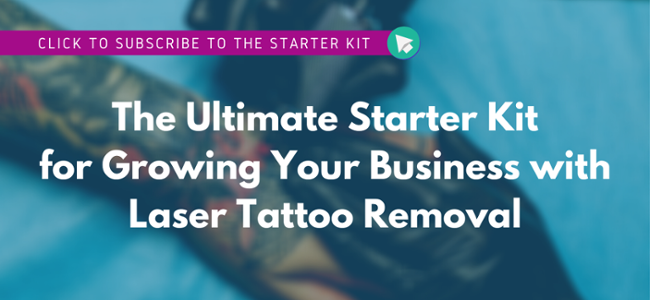
As the demand for tattoo removal continues to rise, those interested in removing a tattoo will likely see several brands heavily marketing their services and products as “quick and easy” tattoo removal solutions. Consumers must understand the actual effectiveness and risks involved in attempting to remove tattoos through various methods.
While laser tattoo removal is the safest and most effective method of removing unwanted ink, tattoo removal patients have likely heard of excision, creams, and injections to remove unwanted ink. Although the lower price point of these products and services may seem appealing, they often come coupled with unwanted scarring, pain, and unimpressive results. In this article, we’ll review these methods of removing tattoos: surgical excision, topical creams, injections, and laser treatments.
Tattoo Removal through Surgical Excision
“Excision” is the process of removing unwanted ink by surgically cutting them out of the skin. The physician numbs the local area, removes the tattoo with a scalpel, and stitches the skin’s edges back together. After the procedure, practitioners commonly prescribe an antibacterial ointment to aid in the healing process. Practitioners recommend patients keep the area bandaged for the first two to seven days following surgery and wash with soap and water.
Although excision is an effective way to remove tattoos, the procedure is not without downsides. Because this procedure requires some form of numbing / anesthesia and a board-certified surgeon, excision is the most expensive treatment route, costing thousands. Most notably, patients receive highly noticeably surgical scars.
Many patients don’t achieve complete removal in a single session, and they have to schedule two to three follow-up surgeries to achieve their desired results. Surgical excision leaves patients with highly noticeable scars and damage to the skin, prompting them to continue to spend money trying to improve the scars’ appearance later on. Surgical tattoo removal is effective, but it may be a better option for patients with smaller tattoos and flexible budgets.
Tattoo Removal Topical Creams
Topical tattoo removal creams are FAR less reputable than excision. Truthfully, tattoo removal creams are considered less of a viable treatment option and more commonplace online scams. These creams and gels are sold mostly online, but some notable retailers like Walmart have carried similar products. A quick Google search for “tattoo removal” will likely present you with a handful of topical creams. Don’t be fooled by the low price (around $50 per bottle) and flashy advertising: these products are notorious for being ineffective.
While their labels typically list “all-natural” ingredients like aloe, eucalyptus, orange peel, rosemary, and sage, their primary active ingredients are often TCA, hydroquinone, or other acids. Marketing attempts for tattoo removal creams often state the product will break down the ink “on a cellular level,” wherein it’s then pushed to more surface-level layers of the skin for easier exfoliation. (Any tattoo owner will tell you that tattoos can not be “exfoliated.”)
These creams boast complete removal despite vague promises, little instructions for use, and lack of messaging as to how the cream works. No topical cream can penetrate the dermis to break apart tattoo ink without causing noticeable scarring and damage to the skin (and discomfort to the patient). Topical tattoo removal creams aren’t known to leave scars – they notoriously don’t work. We recommend patients not waste their time or money on tattoo removal creams.

Tattoo Removal through Injections
Using non-laser “injections” to remove tattoos is not just less efficient; this method is also painful and potentially dangerous. Injectable tattoo removal procedures somewhat mimic tattooing. Instead of injecting ink into the skin, the practitioner typically numbs the area with lidocaine cream and injects a liquid/gel formula with a tattoo needle. This proprietary formula usually promises to “lift” the tattoo ink from the dermis layer of the skin. In the days (or weeks) following the procedure, the tattoo will scab over. Then, the patient waits for the scab to fall off, hopefully revealing a faded tattoo underneath.
These injectable methods often claim to remove tattoos in 4 treatments or less, lasting 30 to 45 minutes per session. Each session costs approximately $100 depending on the size of the tattoo. Common main ingredients in these injectable solutions include seas salt, water, aloe vera, lidocaine hydrochloride (an anesthetic), hydroxyethylcellulose (a thickening agent), and small levels of essential oils and “organic extracts.” We’ve also seen formulas with zinc oxide, magnesium oxide, calcium oxide, isopropanol, triethanolamine, and benzoic acid.
Because the procedure involves breaking the skin with the tattoo needle to inject the formula, this method is similar to applying salt to a wound. Like salabrasion, an out-dated technique that is widely known to cause permanent scarring to the skin, it’s incredibly painful for patients. Essentially, this “non-laser” approach is similar to abrading the skin with sandpaper, injecting acid into the skin, and hoping for the best. Most patients who undergo this procedure experience thick scarring akin to the tattoos they wished to remove.
In all the cases we’ve seen, patients’ skin was raised and thickened. Unfortunately, this procedure causes scar tissue formation in the dermis near the remaining ink, making it even harder to remove it in the future.
Laser Tattoo Removal: The Safest, Most Effective Method for Removing Tattoos
Laser tattoo removal is the only proven, FDA-approved method for safely, effectively, and completely removing unwanted tattoo ink. Unlike creams, injections, and surgical procedures, tattoo removal lasers target the pigment by using appropriate wavelengths to super-heat the ink and break it into smaller particles. This process allows the body then to flush out the ink particles through the lymphatic system.
Tattoo ink particles are too large for the body to filter on its own, so by breaking them down, tattoo removal lasers essentially kickstart a natural process. Depending on the age, size, location, and ink composition of the tattoo, most patients achieve their desired results within 5-10 treatments. Although mildly uncomfortable, treatments usually only last seconds to minutes each. Because these lasers do not break the skin, patients only need to keep the area clean, dry, and out of the sun after treatment.
Patients and practitioners should be wary of older laser technology not designed with every patient in mind. Modern laser tattoo removal technology is safe for all skin tones and can remove all tattoo ink colors. Only Q-switched lasers (like the Astanza Duality and Astanza Trinity) can produce sufficient fluence (energy or power) to remove tattoos without unwanted side effects like scarring or hypopigmentation. Patients don’t have to look far for new laser tattoo removal technology, considering more and more med spas, physicians’ offices, and tattoo shops have adopted the technology to continue to expand their businesses. If you’re a patient interested in receiving a laser tattoo removal treatment with the Astanza Duality or Astanza Trinity, visit this page to find a provider near you.
Learn More About Laser Tattoo Removal with Astanza Technology
Laser tattoo removal is one of the most sought-after aesthetic treatments and creates millions in revenue each year. Astanza strives to provide helpful resources and insights to clients, students, and potential buyers to feel confident moving forward with an aesthetic laser system. Adding tattoo removal services to your existing business can be complicated, so we’ve developed tools to simplify your process.
By subscribing to this exclusive starter kit, you’ll receive a weekly email covering different topics relevant to adding laser tattoo removal to your business. These topics include researching your state’s laser laws, how to get certified in laser tattoo removal, understanding your revenue/potential competitors, discovering your financing options, and more. This starter kit features content from Astanza’s field experts, biomedical engineers, marketing team, and business development managers, hand-selected to simplify your laser-buying journey. Click here or below to subscribe now!









